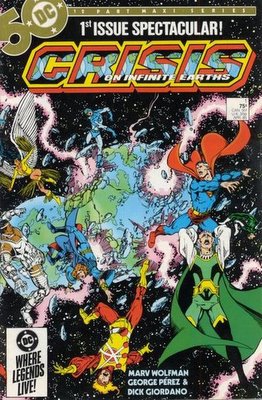As you may or may not know, I have been a lifelong devotee of DC Comics, a respected and powerful comics publisher since 1935 (you’ve surely heard of a few of their characters: Superman, Batman, Wonder Woman, et al). I never cared much for DC’s Johnny-come-lately competition, Marvel – call me naïve if you must, but as an eight year old child, I was always a bit more taken with Superman juggling the moon than with Spider-Man worrying about how he was going to pay his rent.
(Besides, Spider-Man is a fucking idiot. If you don’t believe me, pick a random week and read his eponymous newspaper strip, where you’re likely to find him, say, flying to Los Angeles but forgetting that he has his Spider-Man costume IN HIS CARRY-ON.)
Anyway, DC comics started the super-hero craze in 1938, with the publication of Action Comics #1, and the debut of Superman.

Batman, Wonder Woman, Flash, Hawkman, Green Lantern, and a slew of other costumed vigilantes followed in his wake, and lasted through about 1951, when the Golden Age of the superhero died out to be replaced by cowboys, giant gorillas, and sometimes, cowboys fighting giant gorillas.

So, super-heroes died down for a while, but then in 1956 DC decided to try and refurbish a few of their bigger second bananas from the 30’s and 40’s. Beginning with The Flash, and followed in quick succession by Green Lantern, the Atom, and Hawkman, they soon repopulated their fictional universe with heroes who shared the code-names of their Golden Age counterparts, but little else.
The problem, of course, was that the big guns, and a couple of small guns – Superman, Batman, Wonder Woman, Green Arrow, and my boy Aquaman – had NOT ceased publication for those few years. So, while you had a Flash with a different identity than that of the 1940’s Flash, you had a Superman who was STILL Clark Kent, a Batman who was STILL Bruce Waye, etc…who had interacted with the 1940’s characters and were now interacting with the new characters as well.
DC’s solution was to create a multiverse, and if you’re unfamiliar with quantum physics I’ll summarize: theoretically, an infinite number of universes could exists within the same space, but each universe would have its own unique vibrational rate, so the different universes couldn’t interact – unless, of course, you live in a comic book, in which case interacting with a parallel universe is as easy as flipping on a light switch.
The fun began with a meeting of the Flash with his 1940’s counterpart, which established the existence of Earth-1 (the “modern” Earth, where super-heroes had arisen fairly recently) and Earth-2 (the “Golden Age” Earth, where the heroes had arisen in World War II and were now nearing retirement).

Quick on the heels of that story came the first meeting between the Justice League of America (Earth-1) and the Justice Society of America (Earth-2), where it was established that while some heroes had counterparts that were clearly different people (Flash, Green Lantern), other heroes (Superman, Batman, Wonder Woman) had counterparts who were nearly identical, except for the age difference. This led to several intriguing-but-barely-investigated story possibilities – for instance, the Earth-2 Batman retired, married Catwoman, and had a daughter who became a super-hero herself.
Internal consistency problem solved? No, for the parallel Earths conceit soon got out of hand. Earth – 3 was introduced, a world with no super-heroes, only super-villains. Earth-S was introduced to house Captain Marvel and company (you may know his better by his magic word, “Shazam”), characters acquired from the defunct Fawcett comics. Another set of acquisitions from Quality Comics (Plastic Man and friends) led to the creation of Earth-X, a world where the Nazis had won World War II. And so on.
For their fiftieth anniversary in 1985, the powers-that-be at DC comics decided that they were going to “clean house”, and did so with the 12-issue limited series Crisis on Infinite Earths (the title being an homage to what were then annual meetings between the Justice League and the Justice Society, which always had “Crisis” in the title).

The story, in short: A galactic villain, the Anti-Monitor, decides that all universes composed of positive matter (in other words, all universes) need to be destroyed, and so he sets about doing just that. A lot of hullabaloo ensues, involving every character that DC had ever published, and in the end all the superheroes travel back to the beginning of time and change history, so that instead of a multiple universes being created, only ONE universe was.
The resulting single Earth, in the present, is an amalgamation of the previously-parallel Earths, supposedly preserving the “best” of all realities: The Justice Society did fight during World War II, but without Superman, Batman and Wonder Woman, who according to the new history had not debuted until the modern era.
The Anti-Monitor is finally destroyed by the last remaining “stragglers” from the multiverse, who didn’t fit in the new history: The Golden-Age Superman from Earth 2; Alexander Luthor (son of Earth-3’s Lex Luthor, that world’s first and only super-hero); and the Superboy of Earth Prime (Earth Prime being, supposedly, “our” Earth). Once the Anti-Monitor is disposed of, Alexander Luthor takes the stragglers (along with the Golden Age Lois Lane) off into some sort of ambiguous “paradise”, presumably never to be seen again.
Still with me? Because now is where the fun really begins. Everyone at DC comics circa 1985 apparently had their heads up their asses, or was on drugs, or something, because no one apparently thought ahead to how such a radical change of fictional history would affect the fictional universe as it moved forward. Their first editorial mandate was that all the super-heroes WOULD remember the pre-Crisis multiverse - but a few months later it was decided to revamp Superman, giving him a completely different origin and toned-down powers, and making him the only living survivor of the planet Krypton – which meant that he could not remember having once been MORE powerful, nor could he remember his cousin Supergirl, who had died with great fanfare during the Crisis itself. So, all of a sudden, NO ONE remembered their pre-Crisis life.
Which meant that for all intents and purposes, no story published in the previous fifty years had really "happened".
While the revamp of Superman still had him debuting “several years ago”, the revamp of Wonder Woman had her debuting concurrently with the present – meaning that she now debuted after her own teen sidekick, Wonder Girl.
Batman inexplicably became a psychopathic asshole, who despite hating everyone and everything, was still unwilling to put a bullet through the head of the mass-murdering Joker, who crippled Batgirl and murdered Robin.
Hawkman, who was shown in several post-crisis stories as the same lovable galoot with a mace that he had always been, all of a sudden was also shown to be debuting in the present…which meant that he was not only invalidating all his pre-crisis appearances, but several post-crisis ones as well.
Essentially, the advice to creators seemed to be that they could do whatever the hell they wanted, without worrying about how to explain it.
(For the record, I will here state that the concept of parallel Earths never gave me one iota of confusion, even as a young child – as evidenced by the fact that I have written up to this point without needing to surf the internet for reference).
Now, twenty years later, and with a whole slew of continuity nightmares on their hands, DC has decided to revisit the whole mess with Infinite Crisis, a 7-issue “sequel” (currently on issue 4). The whole DC line has apparently been gearing up for this for quite a while, with lots of intentional continuity screw-ups which will apparently be explained, and lots of bloody super-hero deaths, and an apparent avoidance of any post-crisis editorial lapses (in March, the entire line-up – every title DC publishes – will “jump ahead” one year, so that creators can have a fresh start without screwing things up).
Infinite Crisis, so far, has revealed that the Earth-2 Superman, Lois Lane, Alexander Luthor, and Earth Prime Superboy have been not in paradise, but someplace where they could observe the amalgamated Earth, and boy are they pissed! Most especially Superman, who feels that the modern heroes have strayed from the classic ideal and really made a mess of things. His plan is to somehow “re-do” the crisis, so that instead of Earth-1 being the template for the amalgamated Earth, it will be Earth-2.

Unfortunately for Supes, Alexander Luthor has some sort of other plan which has yet to be fully revealed, and he’s duped Superboy into being his patsy. In issue 4, for example, Superboy-Prime is sent out to talk to the current Superboy (who is not Superman as a boy, but rather a clone created while Superman was dead – still with me?) and ends up accidentally killing about ten people, by knocking their heads off, ripping off their arms, that sort of thing.
Whoopsie!
At the end of issue 4, Alexander Luthor succeeds in splitting the amalgamated Earth back into Earth-1 and Earth-2, though as I hinted earlier, that doesn’t seem to be the complete goal of his machinations (though Golden Age Superman thinks it is).
So, we’ll see. I can’t see how they could possibly put the genie back in the bottle at this point, because they’ve had a whole bunch of characters start remembering their pre-Crisis lives, and now there appear to be two Earths again, which I can’t imagine being an editorial goal, but the only way out of it is to do a universe-wide memory wipe again, which would sort of be a cop-out.
Oh, yeah, and poor Superboy.



1 comment:
Who knew?
Post a Comment